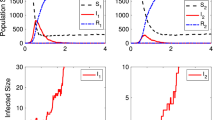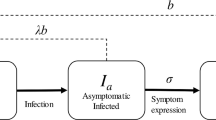Abstract
Plant epidemiologists have long been concerned with the patchy nature of plant disease epidemics. This paper presents a new analytical model for patchy plant epidemics (and patchy dynamics in general), using a second-order approximation to capture the spatial dynamics in terms of the densities and spatial covariances of healthy and infected hosts. Using these spatial moment equations helps us to explain the dynamic growth of patchiness during the early phase of the epidemic, and how the patchiness feeds back on the growth rate of the epidemic. Both underlying heterogeneity in the host spatial arrangement and dynamically generated heterogeneity in the spatial arrangement of infected plants initially accelerate but later decelerate the epidemic.
Similar content being viewed by others
References
Assefa, H., F. van den Bosch and J. C. Zadoks (1995). Focus expansion of bean rust in cultivar mixtures. Plant Pathol. 44, 503–509.
Aylor, D. E. (1982). Modelling spore dispersal in a barley crop. Agr. Meteorol. 26, 215–219.
Aylor, D. E. and F. J. Ferrandino (1989). Temporal and spatial development of bean rust epidemics initiated from an inoculated line source. Phytopathology 79, 146–151.
Bartlett, M. (1957). Measles periodicity and community size. J. R. Stat. Soc. Ser. A 120, 48–70.
Bolker, B. M. and S. W. Pacala (1997). Using moment equations to understand stochastically driven spatial pattern formation in ecological systems. Theor. Pop. Biol. 52, 179–197.
Bolker, B. M. and S. W. Pacala (1999). Spatial moment equations for plant competition: understanding spatial strategies and the advantages of short dispersal. Am. Naturalist 153, 575–602.
Burdon, J. J. and G. A. Chilvers (1976). The effect of clumped planting patterns on epidemics of damping-off disease in cress seedlings. Oecologia 23, 17–29.
Campbell, C. L. and L. V. Madden (1990). Introduction to Plant Disease Epidemiology, New York: Wiley.
Cox, J. T. and R. Durrett (1988). Limit theorems for the spread of epidemics and forest fires. Stoch. Process. Appl. 30, 171–191.
Cressie, N. A. C. (1991). Statistics for Spatial Data, New York: Wiley.
Diggle, P. (1983). Statistical Analysis of Spatial Point Patterns, New York: Academic Press.
Durrett, R. and C. Neuhauser (1991). Epidemics with recovery in D = 2. Ann. Appl. Probability 1, 189–206.
Dushoff, J. (1998). Host heterogeneity and disease endemicity: a moment-based approach, unpublished manuscript.
Ellner, S. P., A. Sasaki, Y. Haraguchi and H. Matsuda (1998). Speed of invasion in lattice population models: pair-edge approximation. J. Math. Biol. 36, 469–484.
Ferrandino, F. J. (1993). Dispersive epidemic waves. 1: focus expansion within a linear planting. Phytopathology 83, 795–802.
Fitt, B. D. L. and H. A. McCartney (1986). Spore dispersal in relation to epidemic models, in Plant Disease Epidemiology, Population Dynamics and Managements, Vol. 1, K. J. Leonard and W. E. Fry (Eds), New York: Macmillan, Chap. 13, pp. 311–345.
Fleming, R. A., L. M. Marsh and H. C. Tuckwell (1982). Effect of field geometry on the spread of crop disease. Protection Ecol. 4, 81–108.
Gressel, J., L. Segel and J. K. Ransom (1996). Managing the delay of evolution herbicide resistance in parasitic weeds. Int. J. Pest Manage. 42, 113–129.
Ihaka, R. and R. Gentleman (1996). R: a language for data analysis and graphics. J. Comput. Graphical Stat. 5, 299–314.
Jeger, M. J. (Ed.) (1989). Spatial Components of Plant Disease Epidemics, Englewood Cliffs, NJ: Prentice Hall.
Keeling, M. J., D. A. Rand and A. J. Morris (1997). Correlation models for childhood epidemics. Proc. R. Soc. Lond. Ser. B 264, 1149–1156.
Kubo, T., Y. Iwasa and N. Furumoto (1996). Forest spatial dynamics with gap expansion: total gap area and gap size distribution. J. Theor. Biol. 180, 18.
Legg, B. J. and F. A. Powell (1979). Spore dispersal in a barley crop: a mathematical model. Agr. Meteorol. 20, 47–67.
Madden, L. V. (1989). Dynamic nature of within-field disease and pathogen distributions, in Jeger, Englewood Cliffs, NJ: Prentice Hall, Chap. 5, pp. 96–126
May, R. M. and R. M. Anderson (1989). The transmission dynamics of human immunodeficiency virus (HIV), in Applied Mathematical Ecology, S. A. Levin, T. G. Hallam and L. J. Gross (Eds), Berlin: Springer-Verlag, pp. 265–311.
McCartney, H. A. and B. D. L. Fitt (1985). Construction of dispersal models, in Mathematical Modelling of Crop Disease, no. 3 in Advances in Plant Pathology, C. A. Gilligan (Ed.), New York: Academic Press, pp. 107–143.
McCartney, H. A. and B. D. L. Fitt (1987). Spore dispersal gradients and disease development, in Populations of Plant Pathogens: their Dynamics and Genetics, M. S. Wolfe and C. E. Caten (Eds), Oxford: Blackwell Scientific, Chap. 9, pp. 109–118.
McElhany, J. P., L. A. Real and A. G. Power (1995). Disease spread, spatial dynamics, and vector preference for diseased hosts: a study of barley yellow dwarf virus. Ecology 76, 444–457.
Metz, J. A. J. and F. van den Bosch (1994). Velocities of epidemic spread, in Epidemic Models: their Structure and Relation to Data, D. Mollison (Ed.), Cambridge: Cambridge University Press.
Milgroom, M. and W. Fry (1988). A simulation analysis of the epidemiological principles for fungicide resistance management in pathogen populations. Phytopathology 78, 565–570.
Minogue, K. P. (1989). Diffusion and spatial probability models for disease spread, in Jeger, Englewood Cliffs, NJ: Prentice Hall, Chap. 6, pp. 127–143.
Minogue, K. P. and W. E. Fry (1983a). Models for the spread of disease: model description. Phytopathology 73, 1168–1173.
Minogue, K. P. and W. E. Fry (1983b). Models for the spread of plant disease: some experimental results. Phytopathology 73, 1173–1176.
Mundt, C. C. and K. J. Leonard (1985). Effect of host genotype unit area on epidemic development of crown rust following focal and general inoculations of mixtures of immune and susceptible oat plants. Phytopathology 75, 1141–1145.
Mundt, C. C. and K. J. Leonard (1986). Analysis of factors affecting disease increase and spread in mixtures of immune and susceptible plants in computer-simulated epidemics. Phytopathology 76, 832–840.
Mundt, C. C., K. J. Leonard, W. M. Thal and J. H. Fulton (1986). Computerized simulation of crown rust epidemics in mixtures of immune and susceptible oat plants with different genotype unit areas and spatial distributions of initial disease. Phytopathology 76, 590–598.
Murray, J. (1990). Biomathematics, Mathematical Biology, Vol. 19, 2nd edn, New York: Springer-Verlag.
Pacala, S. and S. Levin (1998). Biologically generated spatial pattern and the coexistence of competing species, in Spatial Ecology: The Role of Space in Population Dynamics and Interspecific Interactions, D. Tilman and P. Kareiva (Eds), Princeton, NJ: Princeton University Press, Chap. 9, pp. 204–232.
Pielou, E. (1977). Mathematical Ecology, 2nd edn, New York: Wiley.
Rand, D. A. (to appear). Correlation equations and pair approximations for spatial ecologies, in Theoretical Ecology: Advances in Principles and Applications, J. McGlade (Ed.), Oxford: Blackwell.
Satō, K., H. Matsuda and A. Sasaki (1994). Pathogen invasion and host extinction in lattice structured populations. J. Math. Biol. 32, 251–268.
Shaw, M. W. (1994). Modeling stochastic processing in plant pathology. Ann. Rev. Phytopathol. 32, 523–544.
Skellam, J. G. (1951). Random dispersal in theoretical populations. Biometrika 38, 196–218. Reprinted (1991)in Foundations of Ecology: Classic Papers with Commentaries, Leslie A. Real and H. James Brown (Eds), Chicago: University of Chicago Press.
Swinton, J. and R. Anderson (1995). Model frameworks for plant-pathogen interactions, in Ecology of Infectious Diseases in Natural Populations, B. Grenfell and A. Dobson (Eds), Cambridge, England: Cambridge University Press.
Swinton, J., J. Harwood, B. T. Grenfell and C. A. Gilligan (1998). Persistence thresholds for phocine distemper virus infection in harbour seal (Phoca vitulina) metapopulations. J. Anim. Ecol. 67, 15.
van den Bosch, F., H. D. Frinking, J. A. J. Metz and J. C. Zadoks (1988a). Focus expansion in plant disease. III. Two experimental examples. Phytopathology 78, 919–925.
van den Bosch, F., J. A. J. Metz and O. Diekmann (1990). The velocity of spatial population expansion. J. Math. Biol. 28, 529–565.
van den Bosch, F., J. C. Zadoks and J. A. J. Metz (1988b). Focus expansion in plant disease. II. Realistic parameter-sparse models. Phytopathology 78, 59–64.
van den Bosch, F., J. C. Zadoks and J. A. J. Metz (1988c). Focus expansion in plant disease. I. The constant rate of focus expansion. Phytopathology 78, 54–58.
Zadoks, J. C. (1988). 25 years of botanical epidemiology. Phil. Trans. R. Soc. Lond. Ser. B 321, 377–387.
Zadoks, J. C. and F. van den Bosch (1994). On the spread of plant disease: a theory on foci. Ann. Rev. Phytopathol. 32, 503–521.
Author information
Authors and Affiliations
Rights and permissions
About this article
Cite this article
Bolker, B.M. Analytic models for the patchy spread of plant disease. Bull. Math. Biol. 61, 849–874 (1999). https://doi.org/10.1006/bulm.1999.0115
Received:
Accepted:
Issue Date:
DOI: https://doi.org/10.1006/bulm.1999.0115




